







 |
 |
 |
 |
 |
 |
 |
 |
Reed ---- Sue
---- Johnny ---- Ben
---- Others

The original Reed Richards and Sue Storm grew up next door as children, and both Reed and Ben later fought in World War II (see FF11). But Franklinverse Reed and Sue only met 21 years ago (see volume 3, issue 55).
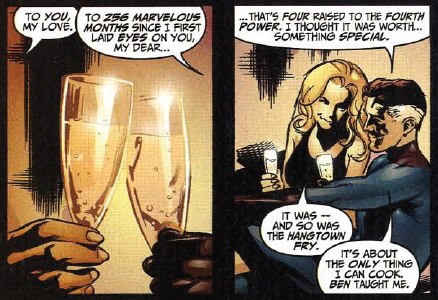
The change from original team appars to happen at the end of FF333. In the next issue, FF334, Johnny seems to have forgotten the 1960s: Sharon jokes about the Beetle being a holdover from the 1960s, and Johnny just confirms his name. But Johnny was the first person to fight the Beetle, in 1964 (or thereabouts) in Strange Tales. Surely if he remembered he would have said something more in reply to Sharon's comment?
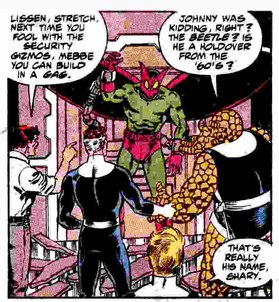
Soon after, Franklinverse Ben makes no mention of ever being in the army. If he had, surely he would have mentioned it in this setting?

The original team's motive was to beat the communists into space. The Franklinverse team's motive was to test for safety.

The original team worked at a secret Pentagon spaceport, probably in upstate New York (it is possible that Ben mis-remembered that last part, but unlikely as he was the pilot). The Franklinverse team left from a private spaceport outside Central City, California.

As noted elsewhere, and especially here, the original team's flight used 1961 technology. Even if we reject that and assume Reed had something special, it was not a hyperspace drive: Reed did not conquer the hyperspace problem until issue 51. The closest he came before that was FF37, using a new device, assisted by a standard NASA Saturn rocket, and almost certainly using the Skrull pathway. Whichever way we look at it, the original team did not have a hyperspace drive in FF1.

The original ship returned to Earth on automatic pilot because Ben was unable to fly it back. The Franklinverse Ben was able to return to the ship to Earth himself.

The original Fantastic Four crash landed in Ithaca, New York (see The Thing issue 10). The new team crash landed in Stockton, California (see FF296: Stockton campaigned for this honor).


Obviously FF296 is still part of the original five acts, but the Franklinverse began to appear in pieces, forced into (and disrupting, replacing) existing continuity. This tiny insertion of a new address into the first page of 296, the first page of act 5, was literally a sign of things to come. By the end of Act 5 Englehart was being forced to change his stories so often that he finally gave up and said he was only providing sound effects - hence his temporary pen name "SFX Englehart". That marked the final end of continuity.
See individual entries below for details.
In the original team, Ben proposed they use their power "to help mankind." In the Franklinverse team Reed proposes, and Ben is reluctant.

The original Ben may have expected Reed to say the same thing, but would he? At this point Reed had shown little concern for others (not worrying about shielding), and is only motivated by science. His first words in the comic were a prayer that the team would not have to spend their time helping others. But when Ben implies Reed was going to be a hero, Reed then has no choice but to agree unless he wants to look like a jerk.
Either way, the original Ben had the idea to help mankind. The original Ben was responsible for the Fantastic Four. This is not some minor footnote: the original four were moral and physical equals, they only differed in how their minds and bodies expressed their power. Reed only claimed moral superiority in Act Two, and this fall apart in Act Four. In contrast, the Franklinverse team is a Mr Fantastic Fan Club, with Ben in the role of a child.
The original team were superheroes. Their purpose was to help people. Ben said it at the start, they were to "use that power to help mankind", and Reed repeated that purpose in FF221. That is, they are heroes. In contrast, the Franklinverse team are not heroes but explorers.


The distinction between heroes and explorer is important: as superheroes, the original teams were equals, and Reed's attempts to rule led to conflict. But as explorers the team is just Reed Richards (the only explorer) and his assistants: Ben and Johnny for comic relief, and Sue is there to prove it's not all male. Franklinverse Reed discovers so many things, so quickly, that success is a foregone conclusion, usually with some invention the reader cannot understand. So any tension is reduced.
The original Monster Isle was in the Pacific. The new Monster Isle is in the Atlantic, in the Bermuda Triangle.

Years later, the Franklinverse Mole Man says he has reigned supreme since he arrived underground.

But the original Mole Man ruled only part of the cave systems: Tyrannus and Kala ruled much of the underworld, and humiliated the Mole Man in FF128. Later he chose to stop ruling for a time, leaving the Lava Men and others to run riot (FF313). For the original Mole Man, confidence was a very thin veneer to hide his fear, sadness and loneliness.
The Franklinverse team and their friends (and enemies) seem unaware of most of what the original team did. Here are two examples, just from issue 1 of volume 3. In the first, Johnny seems unaware that the original Johnny designed a new Fantasti-car specifically to be more stylish. Franklinverse Reed seems unaware that the other car was better: it had a higher speed, greater range, and kept them dry in the rain.

The Franklinverse team frequently returns to events and topics that had finished long ago. For example, the following exchange is the clearest example of the problems that dominated Act 4. Those problems were all resolved in Act 5 when Reed and Sue finally decided to put Franklin first. But the Franklinverse Reed and Sue continually relive Act 4, with Reed making the same empty promises and Sue having the same worries but doing nothing about them.

The Mole Man comes back again...
and again... and again....
All major characters come back again and again, learning nothing.
The first adventure was with the Mole Man, so it's most clearly
seen with him. He comes back again, and again, and again, and
again, and again, and again... sometimes there is the illusion of
character development, but it's just that, an illusion. The original story ending is
ignored. He's just stuck on an endless loop.
A history of time loops
The time loop was bluntly stated in the second part of Steve
Englehart's run (FF322-333). Time loops were the subject of
Walt Simonson's run (FF334-354), which ended with the team being
reset to the past. The time loop is evident throughout Tom
DeFalco's run (from FF355: the first issue was a fill in, but
DeFalco was Editor In Chief). Consider the first 20 issues,
355-374:

Time loops continue thereafter: Franklin ages and de-ages, Valeria ages and de-ages, the team begin again from a new start... nothing ever moves forwards permanently.
In defense of DeFalco
To be fair, it often takes writers a while to hit their stride.
DeFalco's later issues were better: they had some interesting
ideas, like Johnny in jail and more info on Franklin. Plus the
pacing and art were better than most other comics of the early
1990s. From issue 400 the stories became downright interesting,
and showed signs of real character development, but of course this
was was all rebooted after 416. There is a lot to like about
DeFalco's run if you don't want a long term story. But it's not
the same team as before, and that's what this page is all about.
The original team was not stuck
in a time loop.
In contrast the original team invented genuinely new ideas
(or at least new to the comic), then either did not bring them
back or used them to move the bigger story permanently forwards:
e.g Franklins' multiple captures led to Reed and Sue leaving the
team, and Ben and Johnny only bickered when one of them hurt the
other (e.g. by marrying the other guy's girlfriend).
Never moving forwards is
presented as a good thing
After returning from Heroes Reborn, Reed quotes Thomas Wolfe about
never going back, and says Wolfe was wrong. But the stories since
322 illustrate that Wolfe was right: fighting the same old
villains again and again, without any context, without any danger,
cannot be like the first time.

Perhaps the most important change is in realism. Realism was the defining feature of early Marvel, but it's abandoned in the Franklinverse. The lack of continuity (different characters, time loops) are only two examples: there are many more. Take DeFalco's run for example:

An end to plausible deniability
The original team was notable for its plausible deniability: all
the events that seemed impossible could actually have taken place
in the real world. That is they take place in only a small part of
the city, or they can be explained as something else: even if you
lived in New York City it was possible to think that these events
really happened and you were just in the wrong place to notice.
The biggest event, when Terrax took New York into space, was wiped
from our memory because Galactus said he made everything like it
was before.
This all changed with the Franklinverse. From the first moment (FF322) events happened that cannot possible have gone unnoticed. There is no wiggle room: these events do not even pretend to take place in our world.
Occasional realism still
Some writers will pay more attention to realism, some less. So
perhaps we should say there are many different teams, some you can
believe in and some you can't. Either way, this is not a
continuous team from the original 321 issues.
The original Fantastic Four was noted for its creativity: there was always something new. The Franklinverse team is noted for the opposite: The very few new ideas are all variations on old ideas. This is inevitable because ideas arise from their context, and Marvel Time is designed to prevent that context from ever changing.
Examples
This lack of creativity is most striking when the art is at its
best: you see a truly beautiful story, examine it closer, and find
it is empty and dead. Take Carlos Pacheco's run for example. We
see a beautiful version of Diablo and his elementals, a beautiful
versions of the teleportation devices from Kirby's "Him"
story, a beautiful new Baxter Building, beautiful
versions of Annihilus, the negative zone, a beautiful classic
Torch-Namor fight.... everything is beautiful, and everything is
old.
It's as if creativity is banned, so we must raise the profile of all old characters because they are all we have: Paste Pot Pete, Gregory Gideon, Maximus, Janus, Herbie, the Thinker's android, another "new Fantastic Four" featuring old friends and members, heck, even Noah Baxter appears and is now a super genius. Reed sells his patents to mysterious evil group again, Ben gets depressed and wanders Yancy Street again, the team gets stuck in the negative zone again, they find a new race again, the Torch is unable to flame off again, Janus dies for a third time, Ben quits the team again, everything is old.
Counter examples?
Occasionally we do see a new idea, such as the Puritans in the
negative zone, or the Hidden Ones in volume 3 issue 54 (the giant
sized issue where Sue has a baby). Adam Warren's Thing skin things
were particularly good (though some fans hated them). However,
these characters and scenarios can have no lasting impact because
nothing
has a lasting impact in the Franklinverse. So they are
quickly forgotten. The Thing story, for example, was simply a way
to change Ben back to an earlier form. In the Franklinverse
everything ultimately goes nowhere.
One exception:
There may be one counter example from this period: the council of
Reeds. It was introduced in volume 3 issue 58, and become an
important part of Jonathan Hickman's run: it fits well into the underlying Franklin story:
Franklin is a cross dimensional being who wants his father's
attention, and the Fantastic Four comic has followed at least two
of these parallel teams.
Franklinverse Reed often called on Dr Strange (e.g. FF232) and took an interest in the occult, just as he did in other fields (e.g. FF239).

For a few months prior to FF326, Reed spent time in a magical dimension. He then studied grimoires (magical books). He become sufficiently skilled to make a machine that uses magic to solve Johnny's magical problem. Note the Steve Ditko-type tendrils of energy, indicating magic.

Later, Reed stops being curious.

Later, Franklinverse Reed does not believe in magic at all.
He is now unable to read a grimoire, even though the text is aimed
at a four year old and Franklin's life depends upon it.

Another example:
In FF529, Reed says (emphasis added):
Franklinverse Reed is unaware that the "signal" was already explained in FF319: the Beyonders leave the power ready for the first people who are ready to receive it. He also seems unaware that "the exact combination of cosmic rays" have occurred several times before, with no alien visits. E.g. when the Red Ghost got his powers, when the original Reed regained his powers before FF200, and when Ben gained his more evolved form.
Another example:
Franklinverse Reed introduces retinal scans as if they are new,
but the original Reed already had everyone's scans on file and
used them in routine identification: nobody needed to look at a
special camera.
The old Reed routinely whipped up devices to do routine tasks like washing dishes or turning on the oven, or more complex tasks like babysitting.
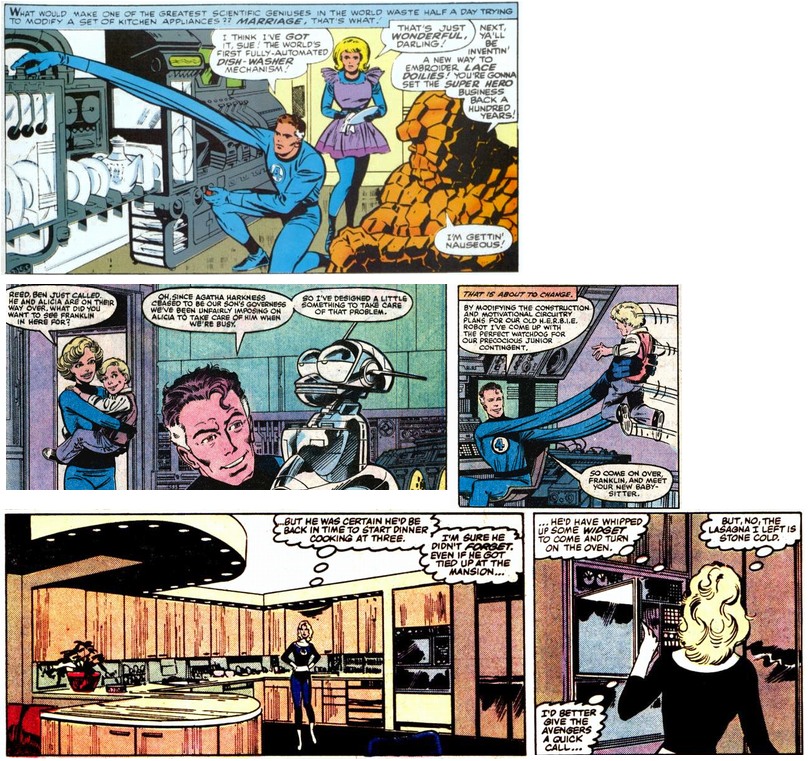
Franklinverse Reed does not:

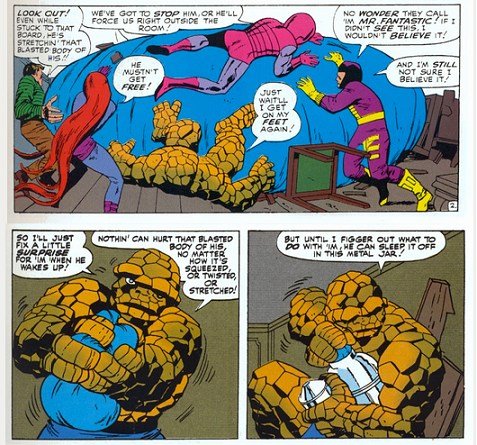
Franklinverse Reed never shrinks. Or at least, I can't find a single example. He used to routinely examine machinery from the inside (so his upper body would shrink to almost microscopic scale). But in Waid's run he had to shrink Ben using a shrinking ray in order to explore ventilation shafts (which also suggests that the Baxter Building's defenses were different and much weaker than before).
From the late 2000s (Mark Millar and Jonathan Hickman's runs) Reed has a reduced ability to expand as well. All the pictures show him becoming noticeably thinner when he stretches, and he stretches very infrequently.
Original Reed could form his body into any shape, including with holes (e.g. when forming a wheel with spokes); Franklinverse Reed apparently cannot.
Original Reed had vast muscular power when stretching: e.g. he thought nothing of stretching horizontally between buildings on the same block (FF11) or catching a passing helicopter (FF4, FF222) or a hunter missile (FF1), or replacing a car wheel while the car is moving (FF3): these require spectacular power, control, speed and resilience. Franklinverse Reed seems unable to do anything like that.
The original Reed had powerful life lessons, so he grew and moved forward. Franklinverse Reed never had those life lessons, so is forever stuck in the past. Take his guilt over Ben's condition. This was decisively overcome in the landmark 25th anniversary issue. But Franklinverse Reed apparently never had that experience.

The original Reed Richards spoke to congress against a superhero
registration act.

Franklinverse Richards strongly supports superhero registration.
His excuse is that he calculated that losing freedom was the only
way to survive.

Reed backed up his claim by having the Mad Thinker check his
calculations. But the Mad Thinker is famous for always missing the
unpredictable factor. In contrast, the original Reed was famous
for never accepting any bad situation as inevitable.
The original Reed example was from FF335, the twilight era between original Reed and new Reed. But he is consistent with the Reed of FF123. This Reed refused to win at the expense of others.

Karen
of Bronze Age Babies comments on this issue: "Galactus basically offers Reed his
version of mutually-assured destruction: if his ship goes, he'll
destroy Earth anyway. The Surfer gives in and tells Galactus
he'll serve him in order to save the planet; but Reed
emphatically tells him, 'No! You must not! Will we never learn
the lesson of history? Not even survival is worth the cost of
abject surrender! There can only be peace through good will -
not the sacrifice of another!' I was struck by what a contrast
this is compared to the Reed of the recent Civil War series, who
seemed to feel that principles were less important than the
final results. Personally, I prefer the guy in this issue!"
Put simply, the original Reed was not a jerk.
The original Sue was only totally freaked out once. When the Malice persona possessed her. She treated it as worse than rape. But the Franklinverse Sue thought having Malice persona inside again her "might come in handy."

To be fair, this was not the "original" Malice. As Reverent
Meteor
explains, "There was a crossover called Infinity War where the heroes
were attacked by alien doppelgangers created by the Magus. These
doppelgangers represented the heroes id/dark side. DeFalco's Malice was
originally one of these doppelgangers". Yet, as representing Sue's dark
side, she was in practice the same as Malice in every respect.
This came after a period where Sue behaved out of character in a different way: she was incompetent. In the "InnerVerse" story she was unable to save her son because her eyes were covered. Hello? This is the woman who can make things invisible?

The original Sue gave up her love for Namor long before the marriage: it's clear in FF27 and FF32 that she loves Reed, not Namor. FF149 showed that Namor would go to great lengths to keep Sue and Reed together. Their love is one of friends with no hint of romance: this is perhaps Sue at her most mature and impressive: a woman who values true friendship above sexual titillation.

In contrast, Franklinverse Sue loves to flirt with Namor. In volume 3 issues 7, we see that her heart's desire is really to be with Namor. This is not just a trick from Joyboy: the previous issue made Franklinverse Sue's romantic feelings abundantly clear.

Just when she needs them, Sue discovers hyperspace powers that let her make stuff explode (or in FF400 lets her walk through a hyperspace wall).

The original Sue was unique: she was the only top level female superhero who did not trade on being a sex object. This (and her natural beauty) made her stand out. This was part of her soft power: she turned enemies into friends (e.g. Namor, the Impossible Man, the Inhumans, etc.), not by showing her breasts, but by her sensitivity.
Franklinverse Sue, on the other hand, has a different approach.

Note that her behavior was already very different from the
original Sue, even before the exposure to Malice triggered the new
costume. Note also that her porn star poses came long after the
Malice persona was driven out.
"The early Torch was far from
the goofball Alfred E. Neuman clone that other writers concocted
in later decades. Silver Age Johnny was brash and resourceful,
more like teenage Steve McQueen in The Blob, the sci-fi flick
that became a rerun regular on color TV. The Human Torch
actually formulated and performed feats to save the day in the
first five FFs:
#1 – sealing off Monster Isle from 'Mole Man’s entire army of
underground gargoyles';
#2 – infiltrating the Skrulls, “Listen, gang! … then watch for
my signal!”;
#3 – catching and thwarting Miracle Man;
#4 – resurrecting Sub-Mariner, then defeating him with a
man-made tornado;
#5 – smoking Doctor Doom out of his castle.
Our peerless pyro was also promoted in early letters on the
'Fantastic 4 Fan Page'. Many fans called the Human Torch their
favorite character, including a poll of 80 voters (FF #17).
Another poll of one FF Fan Club, reported by its secretary (and
future Marvel writer) Mark Gruenwald, tabbed the Torch as Best
Member (FF #19)." (Robert Papetti, "Fantastic Four In The
Silver Age Sixties: A Tribute")
The original Johnny Storm spent many hour practicing and was supremely confident (see Strange Tales and the early pages that explained his powers). After many years in the team there was nothing that phased him.
In contrast, the Franklinverse Johnny sometimes acts like a beginner. As in this example where instead of flying straight upwards he panicked and destroyed everything around himself.

Franklinverse Johnny appears to know much less than the original Johnny. For example, he found it "incredible" doppelgangers might exist. But doppelgangers were a common motif for the original team: they fought Skrulls, the Mad Thinker's robot team, a team created by Galactus, another boy in FF203, the Reed Richards of Counter Earth, and more.

It seems likely that Franklinverse Johnny simply lacks any long term memory, as he seems to have forgotten that his own wife turned out to be a doppelganger, one of their most numerous enemies, the shape changing Skrulls.


The Franklinverse Johnny Storm is a womanizer with multiple girlfriends: this is the real him. But for the original Johnny Storm it was just an act to cover his insecurities. It was just the dream of a boy who lived under his sister's shadow and could rarely get a girl to see him more than once.As we saw in the notes to FF204, Johnny's entire experience with girls since 1961 is basically
Dorrie was never love, and she dumped him. Frankie was relatively brief, and she dumped him. Alicia may have only said yes because Franklin made her do it: she felt sorry for Johnny. The only girl who truly loved him was his soul mate, Crystal, and he never stopped loving her. Much of Englehart's run was about how he realized he made the wrong choice in marrying Alicia, but was too much of a hero to betray his new wife.

Pranks
The original Johnny was not a natural prankster. He was a hothead who needed to prove himself. Back in 1962 Ben was angry and would start fights with Johnny, so for the next couple of years (1963-1965) young Johnny used pranks to make Ben look foolish. But he grew out of it in 1965.
By the late 1960s he was too busy with Crystal, int he early 1970s the team was too depressed for pranks, and in the late 1980s there was too much tension regarding Alicia and then Crystal. But between those points there were no pranks. They annoyed each other sometimes, but that was all.
Johnny fought with Ben in FF233 and FF299, but these were genuine mistakes, not pranks. Johnny was not as confident as he liked to pretend, and valued Ben's friendship as the other single adult, a valued colleague. He was aware of growing older, and his need for love made him act the part:

The Franklinverse Johnny Storm has a completely different personality: the more he can annoy Ben, the happier he is. He also has a differently shaped face and body, but this may be just artistic license.
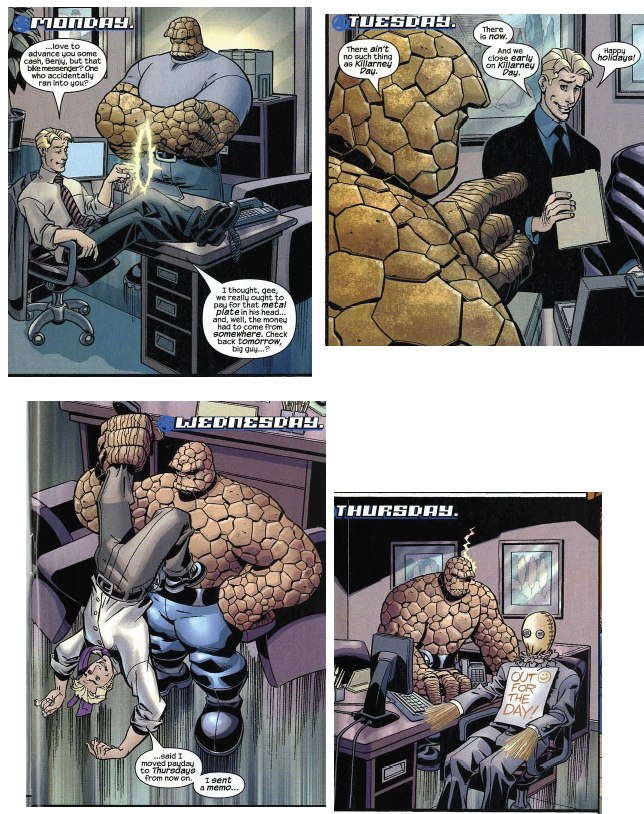
The real prankster
Incidentally, this is a huge missed opportunity: there's no need
for Johnny to act like a child, because they have a real child in
the building! Hey, Marvel, give
Franklin a personality for once! Make him the prankster!
Franklinverse Yancy Street Gang doesn't send messages
The Franklinverse Johnny Storm says he sent all the Yancy Street Gang messages.

But this was not the case with the original Ben and Johnny. The messages began in FF11 before Johnny started pranking Ben, the one time we see the gang they had just sent a letter and were proud of it, and Johnny was also a victim of their pranks

The original Johnny Storm could create flaming versions of himself that could follow people (e.g. in Strange Tales), and opaque images in different colors (FF17), he could generate enough heat to lift a gigantic sea monster (FF4) or slow a falling rocket (FF176), he could refract air to such a degree that images could reflect round corners for hundred of meters (FF10), he could create long lasting cages of fire, and do much more. Franklinverse Johnny did use cages and simple non-following images in DeFalco's run, but seldom thereafter.

Franklinverse Johnny appears limited to burning plus the occasional simple flame image. See for example FF volume 3 issue 4: the Fantasti-car is falling from over 200 feet. The only way he can think of to stop it is to melt the top of a building and hope it becomes sticky! For the original Torch, an updraft would be the obvious solution, considering the relatively low speed and un-streamlined nature of the Fantasti-car (compared with the falling rocket on FF176). Sue could shield them from the heat. Alternatively, they could have formed Sue's forcefield into aerofoil as they did in FF291, when Johnny provided the jet power. Johnny seems to have forgotten that as well.
Once they land, Franklinverse Johnny then uses an updraft to remove air from the flames, showing that:
"Stan Lee called him his
favorite character of the foursome in his 2002 autobiography,
Excelsior! Lee noted that the man turned freak provides the
series with two assets: “a sense of pathos and a constant
opportunity for humor because of his bad attitude.” Twenty-five
years earlier, Lee had summed up the Thing in the prologue of
the 1977 FF Pocket Book Edition: “bad tempered, ill-mannered,
crude, and not the most attractive guy you’re apt to meet.
Therefore, what could be more natural than that he would turn
out to be the FF’s most popular and beloved member!” (Robert
Papetti, "Fantastic Four In The Silver Age Sixties: A Tribute")
When Ben lost this personality it was picked up by Wolverine.
Wolverine also picked up the original Ben's popularity.
A large part of the original story was Ben Grimm's complex psychology: he both did and did not want to be The Thing. Gradually, through Battleworld, the 25th anniversary special, Reed leaving, and experiences with the Beyonder, Ben finally finds peace. Issue 319 sums up the situation: the whole Beyonder story was about being whole, and Ben explains how his own experience has finally made him whole, and freed him from this misery inducing desire. Then he could finally find complete and full love. It's all very Buddhist. To prove he no longer wishes to change, when he has the chance to wish for anything he wants, he does not wish to be human.
But the Franklinverse Ben says this was all on the surface: the old Ben must have lied to the Beyonder, and to Sharon, and to the others, and to himself, because all the time he just wanted to change back.

Franklinverse Ben is basically a teenager, certainly no more mature than Johnny. He competes with Johnny for girlfriends (e.g. Lyja, or Billie the mailman). This contrasts with original Ben, a man of great experience and old fashioned values:

The original Ben was about the bravest guy around.

The new Ben? Not so much.

When is the last time The Thing beat anybody in the Hulk's class, or even near to it? He used to have that strength.
But not any more.

Franklinverse Ben remembers himself as being weaker as well. In FF388 he met either an earlier version of himself or perhaps the original Ben. To prove he is stronger he squashes one of original Ben's barbells. He seems unaware that original Ben could do this as well, and that was before the original Ben's various power increases (FF175, FF214, etc.)

Franklinverse Ben thinks that an extra dose of the same cosmic
rays might make him look human again. (Scan courtesy of R J Carter)
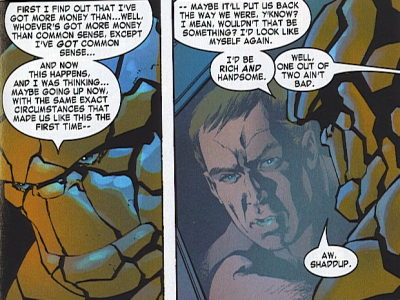
But original Ben knew better: he got an extra dose of rays in FF310 and simply mutated even more.

Original Ben always loved Alicia. When when she married Johnny he still loved her. When he loved Sharon he still had feelings for Alicia (not just in the "what should have been" sequence in FF332, but also in FF317). In Claremont's run, which appears to feature the original team, the last thing Ben says when he thinks he is going to die in some remote place, is Alicia. And Alicia always loved Ben.
But Franklinverse Ben has no feelings for her. There is absolutely nothing keeping them apart in FF393, they are not dating anybody else, and both feel lonely (at this point Ben doesn't even have the Fantastic Four to keep him company). But Franklinverse Ben just walks away. Later he visits her just to tell her he does not love her.
Granted, real people change and sometimes fall out of love. But Franklinverse Ben had no reason to: it's as if a writer just decided "Alicia is boring" and hey presto Ben no longer loves her. This is especially unlikely for Ben: he has old fashioned values, and old fashioned folks mate for life. See for example FF236: original Ben's dream was always to settle down, not to keep looking for a better girl, and certainly not to be alone.

Franklinverse Doom specifically says that the Doom who ran from Kristoff was not him. He says the old Doom was one or more robots. However, that cannot be:
It is more likely that Franklinverse Doom is a robot: a robot brain and abilities could have grown exponentially while in Limbo (the timeless place where Franklinverse Doom gained his shiny costume), whereas a human brain and body could not have grown as easily.

The original Doom was an unforgettable character because we could
sympathize with him. We may disagree, but he has honor and
genuinely loves his people, and protects those loyal to him. (He almost broke that rule once, in the early days
when he tested his robots, but seemed to show remorse before the
villagers were killed. Sue saved them.)


The original Doom was very weak without his gadgets (see FF40). Even the most famous, most noble Doom story, where the team are in Latveria, ends with Doom letting them go because his technology is broken. The next most admired Doom was by John Byrne, and most of his run concerns Doom trying to get back to his land (he gains it briefly in FF247 but loses it again).
But Franklinverse Doom would have no problems with this.

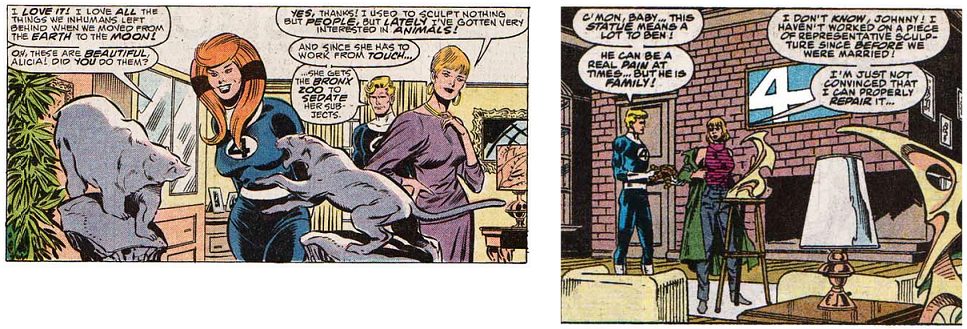
Steve Englehart spent many stories building up Sharon as someone who overcame her problems and was a committed team member. Before that, in her earlier stories, she was always a hero. But Franklinverse Sharon decided one day to be a villain.
Her sudden change was explained by her great desire to be human, even if it meant making a deal with the devil (or in this case Doom). But she was shown as a very intelligent person who had no desire to be human. Sure people change, but this is such a huge change to her character that she looks like a different person.
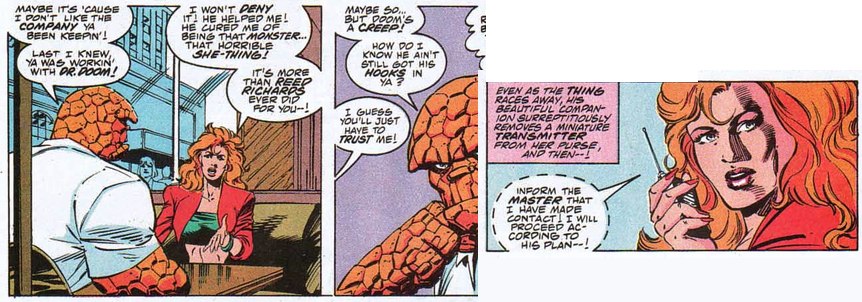
The original Crystal lived a life of duty. She also had a daughter, Luna. The Franklinverse Crystal knows nothing of duty, and apparently has no child.
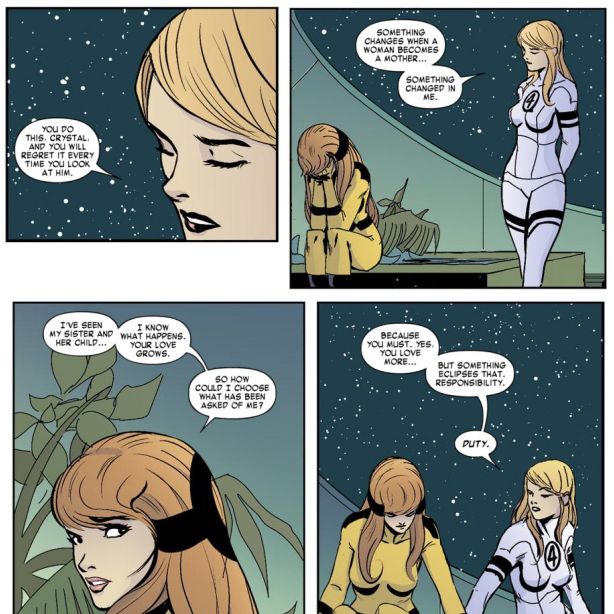
The original Crystal was honorable, except for a few months (Marvel Time) when she was mind controlled by Maximus. But the Franklinverse Crystal takes infidelity and serial partners as her natural state, leading to some fans referring to her with disgust, as " Crystal, the Marvel Universe Bicycle." Never was there a worse example of character assassination.
FF319 was a dramatic conclusion to the Molecule Man saga: he
finally became complete, and his girlfriend was always
characterized by her extreme devotion, more than any other
girlfriend in the Marvel Universe. But for the Franklinverse
Molecule Man, FF319 was not a big deal, and his
girlfriend has left him.

In this list of differences, one period is conspicuous by its absence: Chris Claremont's run, particularly from volume 3 issues 18 to 34. This run shows all the signs of being either the original team or something like it:
This period begins with direct intervention from Franklin: he Franklin powers up the team in issue 8. Did he do more than just power them up, did he shunt in an alternate and more competent team? The period seems to end when the team shunts through multiple realities in issue 34: this is an easy point at which to end up with a slightly different team. Immediately before and after that we have the Franklinverse team again, with recycled villains and Ben and Johnny acting like kids (e.g. with the new Willie Lumpkin). Could it be that the original team returned for a while? An intriguing thought.
